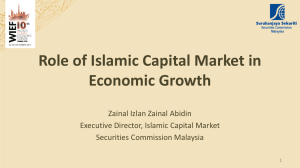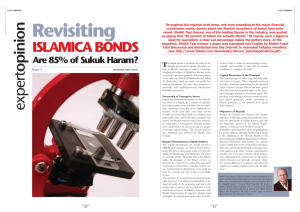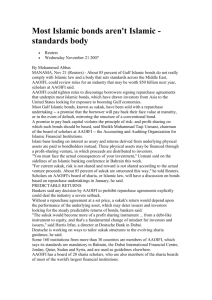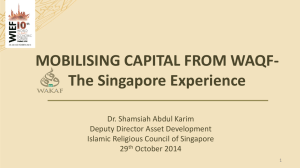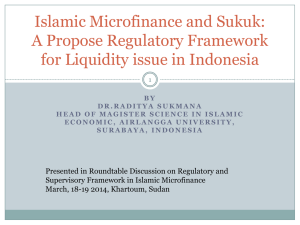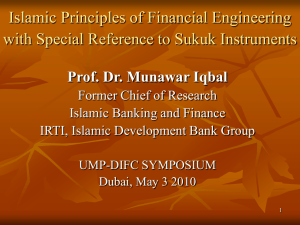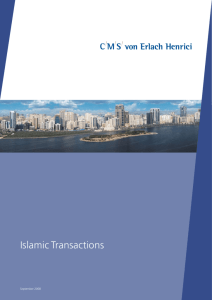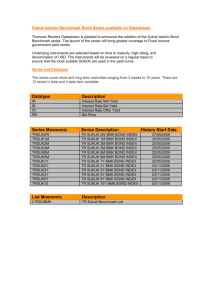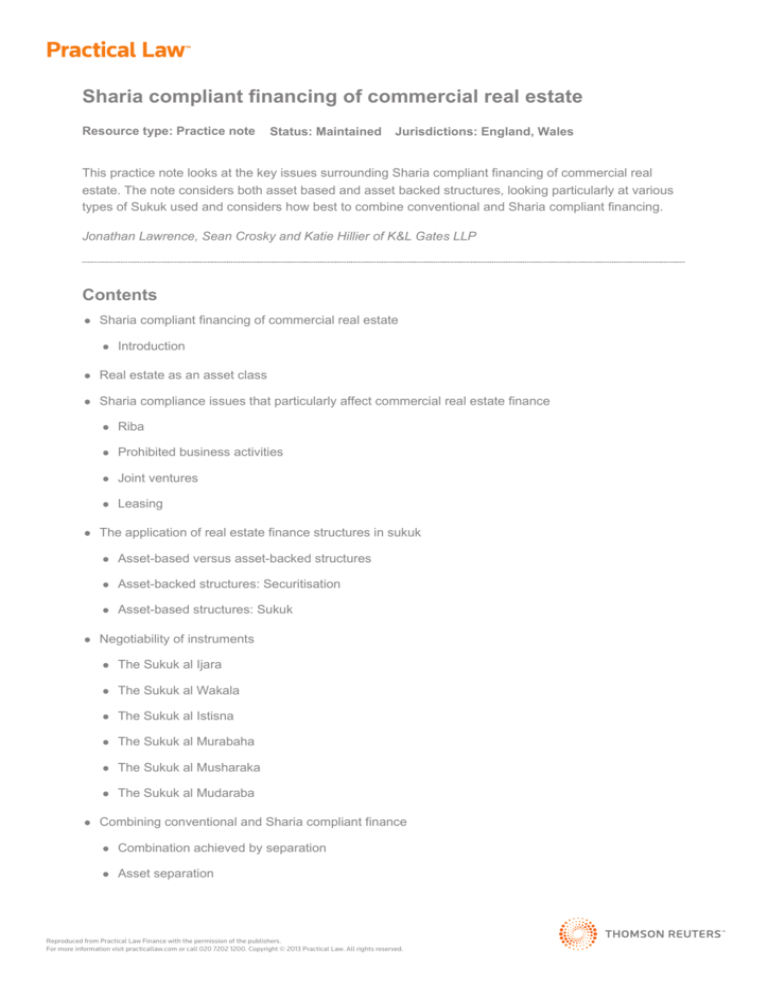
Sharia compliant financing of commercial real estate
Resource type: Practice note
Status: Maintained
Jurisdictions: England, Wales
This practice note looks at the key issues surrounding Sharia compliant financing of commercial real
estate. The note considers both asset based and asset backed structures, looking particularly at various
types of Sukuk used and considers how best to combine conventional and Sharia compliant financing.
Jonathan Lawrence, Sean Crosky and Katie Hillier of K&L Gates LLP
Contents
z
Sharia compliant financing of commercial real estate
z
Introduction
z
Real estate as an asset class
z
Sharia compliance issues that particularly affect commercial real estate finance
z
z
z
z
Riba
z
Prohibited business activities
z
Joint ventures
z
Leasing
The application of real estate finance structures in sukuk
z
Asset-based versus asset-backed structures
z
Asset-backed structures: Securitisation
z
Asset-based structures: Sukuk
Negotiability of instruments
z
The Sukuk al Ijara
z
The Sukuk al Wakala
z
The Sukuk al Istisna
z
The Sukuk al Murabaha
z
The Sukuk al Musharaka
z
The Sukuk al Mudaraba
Combining conventional and Sharia compliant finance
z
Combination achieved by separation
z
Asset separation
Reproduced from Practical Law Finance with the permission of the publishers.
For more information visit practicallaw.com or call 020 7202 1200. Copyright © 2013 Practical Law. All rights reserved.
z
Structural separation
z
Security and intercreditor arrangements
z
Control of cash flow or formal subordination
z
Are priority arrangements needed?
z
Formal intercreditor deeds
Sharia compliant financing of commercial real estate
Introduction
Real estate has been an increasingly important asset class for Islamic compliant transactions and banks.
Islamic compliant finance has proved to be an alternative source of funds entering the European real
estate market.
Several European jurisdictions have sought to attract Islamic finance transactions. The United Kingdom
has, in addition, enjoyed an in-built advantage in its attempt to become the hub of Islamic finance in
Europe. This is due to English law often being the governing law of international Islamic finance
transactions. An Islamic finance transaction might involve a Swiss bank and a Middle Eastern
counterparty, but they may well choose to use English law to structure their documentation in order to
give flexibility and certainty to both sides.
Real estate as an asset class
Islamic finance has used real estate as an investable, tangible asset class on which to base its financial
structures. The focus has tended to be on prime or trophy assets: for example, hotels or large office
headquarter buildings. However, since 2010 Islamic funds and Islamic banks providing mezzanine
finance have multiplied. In such structures, a conventional senior (www.practicallaw.com/2-107-7238)
bank lends the majority of the debt on an interest payment basis, the investors inject their
equity (www.practicallaw.com/6-107-6543) and the mezzanine (www.practicallaw.com/0-107-6843)
finance tranche is put into the structure in an Islamic compliant way. This is a feasible way of ensuring
that deals get done. The senior conventional bank and the Islamic compliant mezzanine lender enter into
an intercreditor agreement which governs the way each loan is treated and takes account of the Islamic
sensibilities of the mezzanine lender. For more information on these structures, see Combining
conventional and Sharia compliant finance.
Student accommodation has been a major target for Islamic funds given the existence of rental
guarantees, steady demand and upward only rental payments. Further developments may be seen in
this sector due to a broadening view of social infrastructure to include healthcare, education and social
housing sectors. Prime residential properties are still a focus.
Real estate has been a primary focus of the Islamic finance industry since the 1990s. Islamic property
investments began in the residential housing sector, but quickly moved to commercial real estate, and
commercial property investments now play a large role in this sector throughout the world.
Reproduced from Practical Law Finance with the permission of the publishers.
For more information visit practicallaw.com or call 020 7202 1200. Copyright © 2013 Practical Law. All rights reserved.
Initial investments were, and continue to be, effected through investment fund structures. However, the
emergence of sukuk (www.practicallaw.com/6-500-6956) in 2003 saw significant changes in Islamic
compliant real estate finance.
Islamic or Sharia (www.practicallaw.com/9-500-7092) compliant finance is a different animal
to conventional finance. For example, the payment and receipt of interest are prohibited by the
Sharia, making it impossible to lend against real estate in a conventional manner. For more
information on Sharia compliant finance and Sharia principles including the prohibition of riba
(www.practicallaw.com/7-500-7093), see Practice note, Islamic finance: UK law overview
(www.practicallaw.com/3-366-1996).
Sharia compliance issues that particularly affect commercial
real estate finance
Riba
A fundamental Sharia principle is the prohibition of riba, best known by its prohibition on the payment or
receipt of interest. This rule affects every aspect of the manner in which a Sharia compliant transaction is
structured and implemented. In the securitisation field, it (and other principles) precludes pooling of
conventional mortgages, credit card receivables, and all interest-bearing debt instruments.
For more information on the principle of riba and its impact on Islamic finance transactions, see Practice
note, Islamic finance: UK law overview: Interest (riba) (www.practicallaw.com/3-366-1996).
Prohibited business activities
The outlook of the Sharia on finance is as a type of ethical investing. It prohibits investment in, or the
conduct of, businesses whose core activities:
z
Include the manufacture or distribution of alcoholic or pork products or, in the case of certain Sharia
Boards (www.practicallaw.com/6-500-7951), firearms.
z
Have a significant involvement in gaming (gambling, including casinos), brokerage, interest-based
banking or impermissible insurance.
z
Include certain types of entertainment elements (particularly pornography).
z
Have impermissible amounts of interest-based indebtedness or interest income.
The activities referred to above are categorised as prohibited business activities. Some Sharia Boards
also include the growing, manufacture and distribution of tobacco within Prohibited Business Activities.
Some Boards interpret the entertainment exclusion more broadly and include cinema and music
generally because of the pornography elements of these industries. Hotels are often included because of
the presence of alcohol in bars and mini-bars or in-room entertainment. Entities that have Prohibited
Business Activities may not be tenants in properties owned and leased by a Sharia compliant investor.
These prohibitions fundamentally influence the nature and operations of funds and businesses. Many
large office buildings and complexes have tenants that engage in Prohibited Business Activities, such as
retail branches of conventional banks, restaurants that serve alcohol, or supermarkets or convenience
Reproduced from Practical Law Finance with the permission of the publishers.
For more information visit practicallaw.com or call 020 7202 1200. Copyright © 2013 Practical Law. All rights reserved.
stores that sell pork, wine and beer. In the purest case, the entire building or complex would be an
impermissible investment. However, the Sharia scholars have taken a pragmatic view. Rules have been
developed that allow investment in these properties for certain impermissible uses, such as those just
mentioned. For example, if the branch bank serves a retail market, there are insufficient other banking
opportunities in the defined area, and the branch bank occupies a small percentage of the property (say,
1 per cent or less), some Sharia Boards will permit the property acquisition and allow renewal of the
lease to that branch bank. The development of these rules as to de minimis impermissible tenancies
greatly expanded the universe of properties available for investment.
Joint ventures
In the area of joint ventures (including partnerships), numerous principles address allocation of work,
profit and loss allocations and distributions and virtually all other operational matters. For example,
as a general statement, all distributions of profits and losses must be pro rata. Preferred shares are
not permissible.
In certain types of partnerships (mudaraba), one person contributes services and another person
contributes capital. If the arrangement suffers a loss, only the capital provider may be penalised in cash.
In other types of partnerships (sharikat and musharaka), work and capital contribution may be allocated
over all partners with corresponding loss sharing. These rules affect real estate business and fund
structures and many operational activities and, directly, sukuk.
Leasing
Sharia principles in relation to leasing are of particular importance because leasing is the primary tool
used in the implementation of Sharia compliant transactions. Examples include the requirement that a
property lessor must maintain the leased property. The lessor may not pass structural maintenance
obligations, or corresponding obligations such as the maintenance of buildings insurance, to a lessee.
In short, the pervasive fully repairing and insuring lease is prohibited. The end-user tenant may not have
prohibited business activities and the lease to the end-user tenant must itself be Sharia compliant.
These principles have a critical impact on Islamic securitisations.
As one would expect in light of the development of the Sharia in Middle Eastern societies that were so
heavily focused on trading activities, the Sharia precepts applicable to sales are especially well refined.
Leasing, in fact, is treated as a type of sale – sale of the temporary possession (or usufruct) of property.
With only limited exceptions, one can sell only tangible assets. Debt cannot be sold, nor can other
financial instruments that do not represent an ownership interest in tangible assets. Further, one cannot
sell property that one does not own and possess. These principles have a major influence on the
structure of Islamic bonds and securitisations. In addition, there are very particular rules addressing
delivery, receipt, ownership, allocation of risk, down-payments and virtually all other aspects of sales
transactions. These rules affect both the ability to create secondary markets and the tradability of
securitisation instruments.
The application of real estate finance structures in sukuk
This section shows how typical Islamic finance structures have been adapted to develop the market for
sukuk (Sharia compliant capital markets instruments) based on real estate assets. Although a number of
Reproduced from Practical Law Finance with the permission of the publishers.
For more information visit practicallaw.com or call 020 7202 1200. Copyright © 2013 Practical Law. All rights reserved.
significant sukuk transactions defaulted (or faced near default) in the global financial crisis, with
issuances of new instruments being very limited during this period, one of the most active areas of
Islamic real estate finance both before and after the global finance crisis has been sukuk issuance. In the
period 2011-2012, we saw an increase in the level of issuance of sukuk across a number of jurisdictions.
Asset-based versus asset-backed structures
Structurally, sukuk can be broken into two types of transactions: asset-based or asset-backed.
Asset-based issuances are sometimes referred to as Islamic bonds, whilst asset-backed issuances are
generally referred to as securitisations (www.practicallaw.com/3-107-7233). There have only been
a limited number of Sharia compliant securitisations, with the vast majority of sukuk issuances being
asset-based transactions.
In both types of sukuk, the issuing entity (which will usually be an orphan special purpose vehicle
company, as used in CMBS transactions) will issue certificates into the capital markets. The proceeds
from the issuance will, depending upon the structure being utilised, either be used to purchase an asset
(such as in an ijara (www.practicallaw.com/8-500-6955) structure), be invested (as in a
musharaka (www.practicallaw.com/2-500-6958) or wakala (www.practicallaw.com/9-500-9543)
structure) or purchase a portfolio of assets (as in a securitisation). It should be noted that in all these
structures, the certificates issued are an indivisible ownership interest in the assets of the issuing vehicle.
This can cause some tax issues. For more information on tax issues affecting Sharia compliant
financing, see Practice note, Sharia-compliant transactions: tax (www.practicallaw.com/4-201-9755) and
Sharia-compliant transactions: VAT (www.practicallaw.com/0-376-4477).
The difference between the asset-backed structures and asset-based structures lies in the type of credit
risk which the investors are taking under each structure in particular, the rights they have to the
underlying assets. This distinction between asset-backed and asset-based structures, comparable to
the rights of bondholders under secured and unsecured bonds is vitally important where there is a
default under the sukuk. In asset-based sukuk, the holders can only require the originator to purchase
the underlying sukuk assets and would have an unsecured debt claim against the originator from the
payment of the purchase price after exercising their rights under the relevant purchase undertaking.
This credit risk profile may not be what some investors expected. The Sukuk holders in an asset-backed
structure would have a claim secured on the underlying asset.
Asset-backed structures: Securitisation
A Sharia compliant securitisation is structurally similar to a conventional securitisation. The issuing
vehicle issues certificates and uses the proceeds of the issuance to purchase a portfolio of assets (such
as Sharia compliant mortgages). The issuing vehicle declares security over this portfolio of assets, and in
the event of a default, the security trustee enforces this security and may liquidate the assets. As with
conventional securitisations, the investors will not have recourse to the seller of the assets on a default;
their recourse will be limited to the assets of the issuing vehicle.
As such, the only structural difference between a Sharia compliant securitisation and a conventional
securitisation is the fact that the instruments are certificates evidencing an ownership right in the assets
Reproduced from Practical Law Finance with the permission of the publishers.
For more information visit practicallaw.com or call 020 7202 1200. Copyright © 2013 Practical Law. All rights reserved.
in relation to the former rather than a debt instrument in relation to the latter. As mentioned earlier, there
have been a very limited number of Sharia compliant securitisations issued (although a larger number have
been structured), the most well known of which was the RMBS (www.practicallaw.com/1-385-1855)
deal issued by Tamweel in 2008, under which a portfolio of Sharia compliant mortgages originated by
Tamweel was securitised.
Asset-based structures: Sukuk
Conversely and from a credit perspective, asset-based sukuk structures are most similar to a corporate
bond. Islamic bonds are based upon the credit of an entity that is participating in the transaction (which
may be the seller, guarantor or other credit support provider and will be referred to as the originator). On
execution of the transaction, an asset will be sold to the issuing entity by the corporate or funds will be
invested with the originator. This asset will generate an income for the issuing vehicle. This income will
be generated from payments made by the originator under the contractual arrangements with the issuing
entity. However, often there will not be any security over the assets of the issuing entity to secure the
certificates (and even where transactions do include security over the assets, it may be that the value of
this security is difficult to ascertain). Only a minority of sukuk are structured to give sukuk holders direct
recourse to the underlying asset. The majority are structured so that, following a default, the only
recourse is to require the originator to repurchase the income-generating asset (either at a fixed price
where fixed price undertakings are permitted by Accounting and Auditing Organization for Islamic
Financial Institutions (AAOIFI) (www.practicallaw.com/3-500-7938) or at some other price as set out
in the documents). AAOIFI intervened decisively in the market in 2008 setting out what they considered
to be acceptable structures for Sharia compliant Sukuk. For more information, see Article, AAOIFI
Statement on Sukuk and its Implications (www.practicallaw.com/7-500-9431)
It should be noted that a large number of sukuk issued have essentially been capital raising exercises for
the underlying corporate, albeit using real estate assets as a way to access this market. However, there
have also been a number of sukuk transactions which have been used to raise capital for certain real
estate and other projects.
Further, a sukuk issuance may be one element of a real estate financing. For example, a CMBS
transaction could be executed which included both conventional bond financing as well as a tranche
structured as a sukuk. There is increased market interest in the establishment of multi-funding platforms
that incorporate tranches of conventional and Islamic finance and there is no reason why these
structures cannot be applied to the commercial real estate market. For more information see Combining
Sharia compliant and conventional finance through the capital markets.
Negotiability of instruments
When structuring a sukuk, it is important to understand the nature of the asset underlying the structure.
Trading in debt above or below par would breach riba principles (being interest) and be impermissible.
As such, where the assets underlying the sukuk are receivables, either the instruments could only
be traded at par, or their transfer must be prohibited. These limitations are generally problematic
in capital markets transactions, where the ability to trade freely is critical for the creation of liquidity.
Many capital markets instruments are held through central clearing systems (such as Euroclear
(www.practicallaw.com/9-107-6240) or Clearstream (www.practicallaw.com/9-107-5924))
which require the instruments to be negotiable and tradeable.
Reproduced from Practical Law Finance with the permission of the publishers.
For more information visit practicallaw.com or call 020 7202 1200. Copyright © 2013 Practical Law. All rights reserved.
The resolution of the apparent riba issue lies in the fact that in a number of sukuk structures (such as an
ijara sukuk) the underlying assets are tangible assets rather than debts and through the trust certificate
structure (under which the assets are subject to a trust declared by the issuing vehicle in favour of a
trustee to be held on trust for the holders of the certificates) the sukuk holders have an interest in a
tangible asset. This structure means that these sukuk can be traded above or below par as the price will
simply reflect that of the underlying asset. This also means,the sukuk can be held in central clearing
systems if required by investors.
The Sukuk al Ijara
The ijara (www.practicallaw.com/8-500-6955) structure that is so widely used in Islamic finance is
readily adaptable to sukuk in a number of different ways. The simplest sukuk issuance utilising the ijara
structure is shown in figure 1. In this structure the issuing entity issues sukuk into the capital markets and
uses the proceeds to purchase an asset from the originator. It then leases the asset back to the
originator. Often the sukuk holders will not have a security interest in the asset (or, where they do have a
security interest in the asset, it may be difficult to enforce due to the difficulties of enforcing security in
local courts where the assets are located). Each sukuk holder is entitled to receive the rental income
generated under the lease pro rata to its ownership interest in the underlying real estate asset based on
the sukuk held by it.
The sukuk al ijara structure in figure 1 has been utilised in a large number of sukuk issuances across the
globe, and is seen by some as the "classic sukuk" due to its relatively simple and understandable structure.
Reproduced from Practical Law Finance with the permission of the publishers.
For more information visit practicallaw.com or call 020 7202 1200. Copyright © 2013 Practical Law. All rights reserved.
For more information on sukuk al ijara and ijara structures, see:
z
Deal structure: Islamic finance - Sukuk al ijara (www.practicallaw.com/3-368-5025)
z
Deal structure: Islamic finance - Ijara (www.practicallaw.com/6-368-5019)
In these structures, the rental stream from the ijara can be structured to produce a precise cash flow
on the sukuk akin to conventional debt capital markets instruments. As such, the rate of return can be
set as a fixed rate or a floating rate, and the capital return profile can be structured such that it is either
through an amortisation schedule, a bullet repayment or a combination of partial amortisation with
partial bullet repayment.
Where the structure involves a bullet repayment or partial bullet repayment at maturity, on the maturity of
the certificates (or the occurrence of certain other events, such as an event of default), the originator will
repurchase the asset at a price fixed at closing. This price will be equal to all amounts owing to the sukuk
holders. Unlike some other structures, the scholars are comfortable with a fixed price purchase
undertaking being used in ijara structures as the clarity and certainty of the fixed price meets key Sharia
criteria. This may be part of the reason why these structures are so popular in the sukuk market.
There are some limitations to the use of the ijara sukuk. For example, many originators do not own
appropriate underlying assets that are subject to Shari’ah compliant leases or can be made available for
such leases during the sukuk term, and, as discussed earlier, in many jurisdictions, there are significant
adverse tax consequences associated with the introduction of the assets into a sukuk structure.
However, a number of authorities such as those in Ireland, France and the UK are keen to encourage
the growth of Islamic finance within their jurisdictions and have worked with participants in the Islamic
finance market to implement regulations to minimise tax issues in sukuk and other Islamic finance
structures. In fact, London, Dublin and Paris are all keen to try and be the centres of Islamic finance in
Europe and have petitioned their relevant tax authorities accordingly. For more information on regulatory
issues and the measures that the UK government have taken to address the issues, see Practice notes:
z
Islamic finance: development of UK as Islamic finance centre (www.practicallaw.com/7-381-9508).
z
Guide to Sharia-compliant alternative investment funds (www.practicallaw.com/7-500-1958).
The Sukuk al Wakala
One structure which we have recently seen utilised on sukuk transactions in the Middle East is the
sukuk al wakala (www.practicallaw.com/7-501-1071). We have seen this financing structure used on
a number of funding structures incorporating conventional and Islamic finance tranches.
In a sukuk al Wakala, the issuing entity as investor appoints the wakeel as agent to invest the proceeds
of the issuance of certificates in accordance with the terms of a wakala. The wakeel will invest the funds
in a portfolio of Sharia compliant assets, which may be a portfolio of assets or parts of an asset already
owned by the wakeel. At the outset, the parties to the wakala will agree the profit return to the issuing
vehicle as investor. This profit return will be paid to the issuing vehicle periodically.
Reproduced from Practical Law Finance with the permission of the publishers.
For more information visit practicallaw.com or call 020 7202 1200. Copyright © 2013 Practical Law. All rights reserved.
A sukuk al wakala structure is shown in figure 2.
Under a wakala structure, any profit is used to pay the profit return to the investor, with the remainder
being retained by the wakeel as an incentive fee. However, there is a risk that the return generated on
the assets may not be sufficient to pay the agreed profit return to the issuing entity, and as such, the
sukuk holders may suffer a loss. Prior to the 2008 AAOIFI Guidelines, a guaranteed profit return
structure was utilised in the market. However, following the issue of the Guidelines, the majority of
scholars appear to be of the view that a fixed rate of profit return is not acceptable in a sukuk al
wakala structure.
We have however seen wakala structures considered in capital raisings by real estate companies, where
the companies want to access conventional and Sharia compliant financing. For example, in the case of
a financing of a shopping mall, certain Sharia compliant parts of the mall could be used as a base for a
wakala with the remainder funded by conventional financing.
For more information on sukuk al wakala, see Deal structure: Islamic finance - Sukuk al
wakala (www.practicallaw.com/9-501-7637).
The Sukuk al Istisna
The sukuk al istisna (www.practicallaw.com/3-501-1068) structure has been discussed as an option
for project financing, where general bank debt or other forms of Islamic financing are not available.
These structures are often referred to as Islamic Project Bonds. However, the structure also has a
number of characteristics which have limited its use by originators.
An istisna is essentially an order to a manufacturer to manufacture a specific asset for the purchaser.
Under a sukuk al istisna, the originator will agree to manufacture or construct certain assets and deliver
those assets to the issuing entity in return for an amount equal to the proceeds of the issuance of
certificates. A classic example is the construction of a factory or manufacturing plant.
Reproduced from Practical Law Finance with the permission of the publishers.
For more information visit practicallaw.com or call 020 7202 1200. Copyright © 2013 Practical Law. All rights reserved.
The issuing entity will then agree to lease the assets back to the originator under a forward lease
agreement, under which it agrees to make rental payments to the issuing entity. On the maturity of
the certificates or the occurrence of other events, such as an event of default, the originator will be
required to purchase the assets from the issuing vehicle for an amount equal to amounts owed to
the sukuk holders.
A sukuk al istisna structure is shown below in figure 3.
However, as noted earlier, there are a number of characteristics that restrict the use of these structures.
In an istisna, there is a construction phase, and then a rental phase. During both phases, the originator
will pay periodic rental payments to the issuing entity. There are concerns that during the construction
phase, the sukuk is only backed by receivables, and as such is not tradable, unless traded at par.
Further, some scholars have shown concern about forward leasing, and there is the risk that if the assets
are not constructed, any advance rental payments would need to be repaid to the originator.
In light of increased interest in project bonds, it will be interesting to see if these structures become more
common, in particular in large multi-funding project finance transactions.
The Sukuk al Murabaha
One sukuk structure which probably has limited utility for commercial real estate transactions, yet merits
a short discussion, is the sukuk al murabaha (www.practicallaw.com/4-501-1416). There have been a
limited number of sukuk al murabaha when compared to other forms of sukuk however, under certain
circumstances, they may be attractive to parties in a capital raising transaction. These forms of sukuk
generally raise capital for general purposes and are not linked to a specific real estate asset of the
originator. However, the capital raised could be used by the originator for real estate purposes, for
example raising funds to be used in financing other real estate projects.
Reproduced from Practical Law Finance with the permission of the publishers.
For more information visit practicallaw.com or call 020 7202 1200. Copyright © 2013 Practical Law. All rights reserved.
A bond-type sukuk al Murabaha is shown below in figure 4
The sukuk al murabaha is issued to the sukuk holders by the Issuer. The sukuk represents
a “participation interest” in the underlying murabaha transaction. The issuance proceeds are used to
purchase a metal on the spot market, the metal is then sold to the originator on a deferred payment
basis, and the originator sells the metal to the Metal Purchaser on the spot market. The net result is that
the originator holds cash equal to the spot market price of the metal which it can use in its real estate
operations and the originator has a deferred payment obligation on the Murabaha Agreement that is
used to service the sukuk.
Figure 5 below illustrates a murabaha sukuk in which the deferred murabaha payment obligations under
a pool of murabaha transactions are pooled, and the Issuer sells a sukuk based on that pool.
Reproduced from Practical Law Finance with the permission of the publishers.
For more information visit practicallaw.com or call 020 7202 1200. Copyright © 2013 Practical Law. All rights reserved.
Under these murabaha sukuk structures, the party needing financing (the originator) obtains cash only
by selling the tangible asset (the metal or other asset). Thus, on an ongoing basis, this sukuk does not
represent an ownership interest in a tangible asset – it has been sold – and only the deferred debt
obligation (a receivable) remains after sale of the asset.
As such, the assets underlying the sukuk are debts. One of the general principles of the Sharia is that
debt cannot be traded except at par. As such, the certificates issued in a sukuk al musharaka cannot be
negotiable instruments and traded on the secondary market. This limits the possible investor base for
these types of instruments. However, there have been a number of recent transactions which have
utilised a sukuk al musharaka structure where the investors have agreed to hold the assets for the term
of the transaction.
Further, it is possible for a sukuk to have a number of underlying structures, including a murabaha
structure, where the receivables derived from the murabaha are a small proportion of the
overall structure.
It should be noted that the position of scholars in South East Asia is somewhat different to the position
of scholars outside of that region. The South East Asian scholars accept that a murabaha may be used
as the basis for a tradeable sukuk, making this structure a common feature of the capital markets in
that region.
For more information on Sukuk al Murabaha and Murabaha, see
z
Deal structure: Islamic finance - Sukuk al murabaha (www.practicallaw.com/8-502-0032)
z
Deal structure: Islamic finance - Murabaha (www.practicallaw.com/0-368-5022)
Reproduced from Practical Law Finance with the permission of the publishers.
For more information visit practicallaw.com or call 020 7202 1200. Copyright © 2013 Practical Law. All rights reserved.
The Sukuk al Musharaka
In the sukuk al musharaka (www.practicallaw.com/3-500-7349), the issuing entity enters into a joint
venture or partnership arrangement, pursuant to a “Musharaka Management Agreement”, with the party
seeking financing (the “Musharaka Partner”). As noted above, each party may contribute capital to the
musharaka. Each of the partners receives “units” or “hissas” in the musharaka in accordance with their
respective capital contributions. The Issuer’s capital contribution is in cash and equals the proceeds of
the sukuk issuance. The contribution of the Musharaka Partner is usually an in-kind contribution of a
tangible asset (such as a piece of real estate). A musharaka structure is depicted in Figure 6.
The Issuer and the Musharaka Partner enter into a purchase undertaking pursuant to which the Issuer
can require the Musharaka Partner to purchase designated units or hissas on specified dates either
during the term of the sukuk or at maturity. Where units are purchased throughout the life of the
transaction, the structure is referred to as a diminishing musharaka. Economically, this is akin to an
amortising bond. Alternatively, the units may only be repurchased on maturity (or other certain events), in
which case the sukuk is economically akin to a bond with a bullet repayment.
Under the musharaka structure, the issuing entity will receive profit distributions from the musharaka and
the proceeds from sales of the units or hissas, which are then distributed to the sukuk holders in
accordance with agreed formulae. Although profits and losses are required to be shared between the
partners in accordance with their share of total units in the partnership, a number of sukuk transactions
have been structured such that all profit has been paid to the issuing entity in priority to the Musharaka
Partner, until such time as the issuing entities' contribution has been reduced to zero (and the sukuk
holders have been repaid in full).
Reproduced from Practical Law Finance with the permission of the publishers.
For more information visit practicallaw.com or call 020 7202 1200. Copyright © 2013 Practical Law. All rights reserved.
A set of issues arise in any financing in which capital is needed periodically (these issues also affect
other structures, such as the musharaka). Consider, for example, the construction of a large-scale
project where the construction cycle extends over a period of years and there is no project income during
that period. All involved parties will desire that there be certainty of capital availability throughout the
construction period. Periodic sukuk issuances do not provide that certainty. An initial sukuk issuance for
the full amount of the construction costs will provide that certainty, but is economically inefficient. The
issuance proceeds in excess of immediate needs will be invested in short-term investments (such as
murabaha) that have low rates of return. In addition, the sukuk holders will probably expect periodic
returns from the inception of the transaction. The project itself will be generating no income (it is in the
construction phase) and the reinvestment income will be low. Payments on the sukuk during the
construction and ramp-up phase are essentially self-funded by the sukuk holders.
In 2008, AAOIFI issued guidelines (the “2008 AAOIFI Guidelines”) which set out the parameters of
how an exercise price under the purchase undertaking could be calculated. Prior to the issuance of
the 2008 AAOIFI Guidelines, the exercise price would have been stipulated under the purchase
undertaking as an amount equal to all amounts owing at the time of exercise to the sukuk holders.
However, following the issuance of the Guidelines, where the purchaser under the purchase undertaking
is the Musharaka Partner, the exercise price cannot be set at closing, but rather is required to be
calculated on the basis of the market value of the assets on the date on which the purchase undertaking
is exercised. As such, there is the risk that the exercise price may be less than the amounts owing to
sukuk holders. Although structural mitigates can be built into a sukuk transaction utilising a musharaka
structure (such as reserve funds and Sharia compliant liquidity features) these may not entirely remove
the risk of payment default under the certificates on the exercise of the purchase undertaking.
For more information on the 2008 AAOIFI Guidelines, see AAOIFI Statement on Sukuk and its
Implications (www.practicallaw.com/7-500- 9431).
As such, the use of the sukuk al musharaka structure has declined in popularity following the issue of the
2008 AAOIFI Guidelines.
For more information on Sukuk al musharaka and musharaka, see
z
Deal structure: Islamic finance - Sukuk al musharaka (www.practicallaw.com/1-368-5026)
z
Deal structure: Islamic finance - Musharaka (www.practicallaw.com/8-368-5023)
There are historic deals based on this structure and some jurisdictions and counterparties may not
subscribe to the AAOIFI Guidelines and therefore continue to use the structure. However, it has become
less mainstream.
The Sukuk al Mudaraba
The mudaraba structure may also be incorporated into a sukuk offering in a number of different variants
of the sukuk al mudaraba (www.practicallaw.com/3-501-0653). A generalised generic form of a sukuk
al mudaraba is set forth in figure 7.
Reproduced from Practical Law Finance with the permission of the publishers.
For more information visit practicallaw.com or call 020 7202 1200. Copyright © 2013 Practical Law. All rights reserved.
The Rabb ul-maal Issuer sells the sukuk to the sukuk holders and the proceeds of that issuance provide
the capital for the mudaraba. The Mudarib will conduct the business of the mudaraba as the provider of
services. As noted above, this is similar to a limited partnership or limited liability company.
This mudaraba may constitute the only entity necessary for the conduct of the relevant business. Or, as
is more likely in a complex project or undertaking, this mudaraba may enter into joint venture and/or
other contractual arrangements with other parties. For example, in a complex project financing this
mudaraba may enter into a further joint venture with a project sponsor in connection with the financing,
construction and operation of the project.
Some of the primary structural considerations will focus, at each level of the transaction, on principles
pertaining to allocation and distribution of profits and losses, and the permissibility of capital contributions
by the Mudarib.
There have been very few sukuk al mudaraba issuances and following the 2008 AAOIFI Guidelines,
under which AAOIFI stated that the use of a fixed price purchase undertaking was prohibited in
sukuk structures, it is expected that these structures will remain rarely used. For more information
on the 2008 AAOIFI Guidelines, see AAOIFI Statement on Sukuk and its Implications
(www.practicallaw.com/7-500-9431).
For more information on sukuk al mudaraba and mudaraba, see:
z
Deal structure: Islamic finance - Sukuk al mudaraba (www.practicallaw.com/8-501-7633)
z
Deal structure: Islamic finance - Mudaraba (www.practicallaw.com/2-368-5021)
As with the Sukuk al Musharaka, the Sukuk al Mudaraba may still be used in a legacy fashion.
Reproduced from Practical Law Finance with the permission of the publishers.
For more information visit practicallaw.com or call 020 7202 1200. Copyright © 2013 Practical Law. All rights reserved.
Combining conventional and Sharia compliant finance
Combination achieved by separation
Combining funds received from such different sources will involve some form of separation between the
conventional finance and the Sharia compliant finance in order to ensure that the Sharia compliant
finance is not tainted by the charging of interest and other non-compliant elements of conventional
lending. The extent of that separation will depend upon the agreed commercial terms and the
requirements of the Sharia compliant parties to the transaction.
Asset separation
A Sharia lender may only require compliance of its own relationship with its borrower and avoid looking
further into the general compliance of the borrower or the borrower's other business relationships and
activities. Such a lender may be content to deal with the same entity as constitutes the borrower under
conventional financing, and separate the two types of funding by distinguishing the assets charged by
way of security, and the income available, to the conventional lender from those on which the Sharia
finance is secured. This method has the added advantage of making Sharia finance available where it
may not otherwise have been, by means of dividing a property portfolio into units which are acceptable to
Sharia investors and those which are not. The units which are not acceptable will typically house
businesses conducting prohibited activities, such as a conventional bank or a bar. It may even be
possible to achieve this result within an individual property, such as a hotel, by demarcation of the area
of, and the income from, the bar/restaurant, so that Sharia finance is not associated with the part of the
business profiting from the sale of, for example, alcohol or pork products.
Structural separation
On the other hand, a greater degree of structural separation between the conventional and Sharia
finance may be required. Ultimately, the structure will be determined on a case by case basis, influenced
to a large degree by the particular requirements of the Sharia advisors to the Islamic compliant party.
Figure 8 below illustrates one of the ways in which Sharia and conventional finance can be combined for
use in the context of a real estate investment, by way of structural separation.
Reproduced from Practical Law Finance with the permission of the publishers.
For more information visit practicallaw.com or call 020 7202 1200. Copyright © 2013 Practical Law. All rights reserved.
In figure 8, the Sharia compliant financing occurs between the parties highlighted in orange and blue and
is a Tawarruq (www.practicallaw.com/0-500-7077) (or reverse/monetising murabaha) whereby the
holding company's (HoldCo) immediate onselling of the commodity purchased leaves it with:
z
A sum of money to be used for investment.
z
A deferred payment obligation (with agreed mark up) to the Financier in respect of the
commodity purchased.
HoldCo uses the monetised sum to make an equity investment in its subsidiary (PropCo) and/or to grant
a shareholder loan (which may or may not be interest bearing depending upon the view taken by the
Sharia scholars advising the Financier). PropCo combines those funds with money it has borrowed by
way of a conventional loan and purchases real estate.
The Financier, which may be an SPV established for the purpose of a specific investment opportunity,
operates in a Sharia compliant manner and its relationship with HoldCo is fully compliant with Sharia
principles. In this case, the Financier does not look into the compliance of the business transactions of
HoldCo's subsidiary, PropCo. Therefore, PropCo is not required to be Sharia compliant, hence it is able
to enter into conventional financing arrangements. However, it is worth noting that, if both the Financier
and PropCo are SPVs under the umbrella of a larger Sharia compliant financial institution it may be that
the nature of PropCo's investments are restricted. For example, it may be prevented from investing in a
property used for businesses, such as gambling and weapons, which are prohibited by Sharia principles.
Security and intercreditor arrangements
In some cases the Sharia compliant lender and the conventional bank enter into formal intercreditor
arrangements. Whether they do so, and what documentation may be necessary, will be influenced by the
interplay between the commercial terms of the deal and the compliance principles of the Sharia lender(s).
Reproduced from Practical Law Finance with the permission of the publishers.
For more information visit practicallaw.com or call 020 7202 1200. Copyright © 2013 Practical Law. All rights reserved.
Control of cash flow or formal subordination
For the structure illustrated by figure 8 above, the terms of the conventional finance documents would
typically control PropCo's cash flow so that income from the property is paid into an account controlled
by the conventional bank and goes first to service payments due in respect of the conventional loan.
In addition, the conventional finance documents may also limit PropCo's ability to distribute funds to
its parent, HoldCo. Dividend payments may be restricted so that they can only be made in certain
circumstances, such as while no default is continuing under the conventional finance documents.
Where HoldCo makes a shareholder loan, such loan may be formally subordinated in a subordination
deed between the conventional bank, PropCo and HoldCo. This may be a requirement for the
conventional lender and, depending on the requirements of the Sharia Financier, might require further
structural separation so that HoldCo is not the same party which enters into any such subordination.
Whether purely as a result of the structure and the conventional bank's control of cash flow, and/or by
a formal subordination deed, the effect is that the Islamic compliant finance is subordinated to that of
the conventional bank. For more information on subordination arrangements, see Practice note,
Subordination (www.practicallaw.com/7-242-0147).
Are priority arrangements needed?
Figure 8 above illustrates that, as well as granting conventional security to the bank, PropCo may enter
into a sale undertaking in favour of the Financier, which gives the Financier the right to call for the real
estate to be transferred to it. This may seem broadly analogous to third party security for HoldCo's
payment obligations under the murabaha, but there are some crucial differences:
z
The undertaking is not expressed to be granted by way of security.
z
The Financier's rights pursuant to the undertaking are not, unlike conventional security, exercisable
only where HoldCo defaults.
Given the second of these points, the conventional lender is likely to require some comfort that its
security has priority over the Financier's rights under any such sale undertaking.
There are a number of ways this could be achieved:
z
The sale undertaking itself could acknowledge that both PropCo and the property are subject to the
terms of the conventional finance documents, so that if the Financier exercised the undertaking it
would take possession of the property subject to the security.
z
The sale undertaking could also terminate automatically on the occurrence of an event entitling the
conventional lender to enforce its security, which should address concerns that the Financier could
exercise the undertaking if PropCo enters financial difficulties.
z
Most practically, in a real estate transaction, the effect of registering the conventional lender's security
at the Land Registry will give rise to a restriction on the title. This will effectively mean that the sale
undertaking cannot be exercised without the conventional lender's written consent. That ought to
be true, whether or not the sale undertaking is registered as an option over the land in question,
provided there is sufficient evidence of the parties' intentions that the sale undertaking is subject
to the conventional lender's security. For more information on these restrictions on title and
how they affect the sale of land see Practice note, Mortgages and charges over land
(www.practicallaw.com/2-107-4640).
Reproduced from Practical Law Finance with the permission of the publishers.
For more information visit practicallaw.com or call 020 7202 1200. Copyright © 2013 Practical Law. All rights reserved.
Formal intercreditor deeds
In certain circumstances, Sharia and conventional lenders may enter into formal intercreditor
documentation, documenting the priority of payments and the ranking of security. This is most likely to be
the case where the structural subordination achieved in the structure illustrated above is not possible and
where the same entity is the borrower under both the conventional and Sharia finance. An intercreditor
agreement between Sharia and conventional lenders is likely to deal with many similar matters covered
in such an agreement between solely conventional lenders, with such adaptation as may be required to
account for the Sharia financing structure and the compliance requirements of the Sharia parties.
Matters which could be addressed may include:
z
Allocation of the borrower's operating income.
z
Allocation of proceeds following acceleration on default.
z
What the different lenders can and cannot do in respect of their facilities.
The intercreditor agreement may need to identify the respective rankings of payments under the Sharia
and conventional finance documents to deal with allocation of income or proceeds following acceleration.
However, Sharia financiers may regard it as important that the payment waterfalls dealing with the
process of payment are kept separate in the Sharia compliant and conventional finance documentation.
This is to avoid the possibility of the payment of interest to the conventional lenders tainting the Sharia
compliance of the Sharia lenders.
For more information on intercreditor deeds, see Practice notes, Intercreditor deeds:
overview (www.practicallaw.com/5-107-4035).
Reproduced from Practical Law Finance with the permission of the publishers.
For more information visit practicallaw.com or call 020 7202 1200. Copyright © 2013 Practical Law. All rights reserved.

